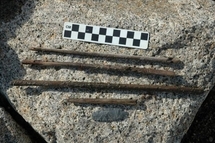Melting ice reveals ancient hunting tools in Canadian north
Michel Comte
OTTAWA, Michel Comte- Melting ice in Canada's far north has revealed a treasure trove of ancient tools used to hunt caribou and other prey, researchers announced Tuesday.
High in the Yukon's Mackenzie Mountains, Canadian archaeologists have discovered 2,400-year-old spear-throwing tools, a 1,000-year-old ground squirrel snare, and bows and arrows dating back 850 years.

This handout from the Government of Northwestern Territories (GNWT) shows a birch arrow, in four pieces, and the stone projectile point (arrowhead), dated as being 270 years old.
"There are wooden arrows and dart shafts so fine you can't believe someone sat down with a stone and made them," he said in a statement.
The tools were discovered in patches of ice where caribou have gathered for millennia to escape heat and insects, abandoned in layers of dung and annual deposits of ice by ancient hunters who followed the animals to these icy oases.
Biologists involved in the project are also examining dung for plant remains, insect parts, pollen and caribou parasites.
Others, meanwhile, are studying DNA evidence to track the lineage and migration patterns of caribou.
Andrews started his search in 2000, scanning satellite imagery of the Mackenzie Mountains to locate and examine ice patches after a 4,300-year-old dart shaft was discovered in the area three years earlier.
Sheep hunters had stumbled upon the artifact in layers of caribou dung exposed by receding ice believed to be caused by global warming.
This led to the discovery of a repository of well-preserved artifacts and the birth of so-called "ice patch archeology."
"I'm never surprised at the brilliance of ancient hunters anymore. I feel stupid that we didn't find this sooner," said Andrews.
Now a race is on to search out and collect artifacts from these sites before they are trampled by caribou or dissolved by acidic soils.
Two of the original eight ice patches in the area where caribou were known to bed down until cooler temperatures prevailed at lower altitudes, according to Andrews, have already disappeared.
"We realize that the ice patches are continuing to melt and we have an ethical obligation to collect these artifacts as they are exposed," he said. "In a year or two the artifacts would be gone."
---------------------------------------------------------------------------------